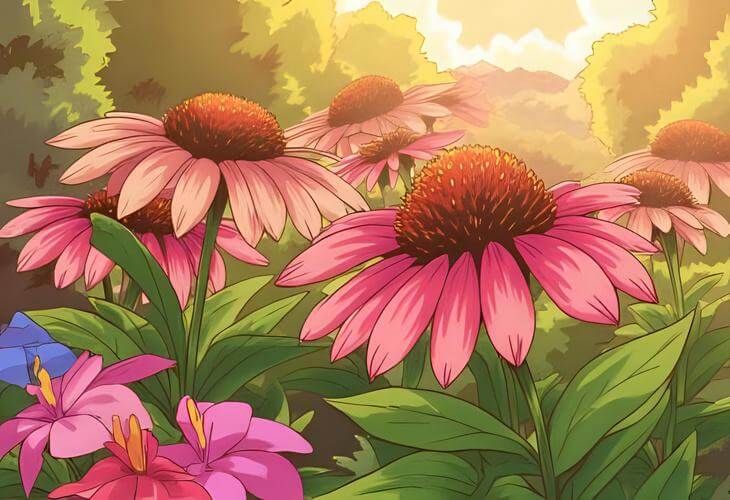
Coneflowers (Echinacea spp.) are hardy North American natives that have earned their place in gardens across the country for their striking daisy-like blooms, long flowering season, and outstanding pollinator appeal. Most easily recognized in their classic purple form, coneflowers now come in a variety of colors, shapes, and sizes thanks to years of successful hybridization.
With a prominent cone-shaped center surrounded by vibrant petals, coneflowers bloom profusely from early Summer through Fall. They’re incredibly easy to grow, drought tolerant once established, and offer food and habitat to beneficial wildlife. Whether planted in native prairie beds, cottage gardens, or modern landscapes, coneflowers shine as both an ornamental and ecological addition to your garden.
Soil (pH) Requirements
Coneflowers thrive in well-draining soil with a neutral to slightly acidic pH between 6.0 and 7.0. They tolerate poor or rocky soils and actually dislike overly rich or wet conditions.
Tips for Soil Success
- Avoid heavy clay or soggy areas.
- Add compost or sand to improve drainage if needed.
- Once established, they rarely require fertilization.
Sun Requirements
For best results, plant coneflowers in full sun, giving them at least six to eight hours of direct light per day. This promotes strong stems, abundant blooms, and maximum nectar production.
Sunlight Tips
- In cooler zones, full sun is essential.
- In hotter southern regions, light afternoon shade can help reduce heat stress, especially for newer cultivars.
Watering Requirements
Coneflowers are low-maintenance once rooted in. While they prefer regular watering as seedlings, mature plants are notably drought tolerant.
Watering Guidelines
- Water deeply but infrequently—once per week is usually sufficient.
- Overwatering can cause root rot or floppy stems.
- Mulch to retain moisture and suppress weeds, but leave space around the crown to prevent rot.
Best Plant Hardiness Zones
Coneflowers are long-lived perennials in USDA Zones 3–9, making them incredibly adaptable across most of the United States.
Seasonal Tips
In cold zones, leave spent flowers standing through winter for visual interest and seed for birds.
Deadhead in midseason for extended blooming, or let them go to seed for Fall interest and self-sowing.
Why Coneflowers Are a Garden Staple
Coneflowers are treasured for their rugged charm, vivid color, and ecological importance. Their cone-like centers serve as landing pads for pollinators, while the petals beckon bees, butterflies, and even hummingbirds. Later in the season, their seedheads become an important food source for songbirds like finches and chickadees.
Coneflower Highlights
- Long bloom time (June through frost)
- Excellent cut flowers and dried seed heads
- Resistant to deer and adaptable to poor soils
- Serve as a nectar magnet in pollinator gardens
Pollinators That Love Coneflowers
- Honeybees, which forage from early morning until evening
- Bumblebees, attracted to cone-shaped centers rich in pollen
- Butterflies, including monarchs and painted ladies
- Hoverflies, which also act as garden pest controllers
- Occasional hummingbirds, particularly when other nectar plants are nearby
Five Standout Coneflower Varieties and How to Use Them
Purple Coneflower
The classic native coneflower, E. purpurea, features soft lavender-pink petals and a coppery orange center cone. It reaches 2–4 feet tall and is a staple in wildflower meadows, butterfly gardens, and prairie plantings.
Top Uses
- Native restoration plantings
- Herbal teas and tinctures (roots and flowers)
- Seed source for finches in Winter
Pollinator Appeal: A top favorite for bumblebees, honeybees, and monarch butterflies
Zones: 3–9
PowWow Wild Berry
A compact, floriferous variety, PowWow Wild Berry features intensely magenta-pink blooms and a neat, mounded shape. It flowers early and prolifically, even in its first year.
Top Uses
- Small-space or container gardens
- Edging sunny borders and pathways
- Bright color in pollinator plots
Pollinator Appeal: Excellent nectar source for solitary native bees and a favorite of hoverflies.
Zones: 3–8
White Swan
Elegant and understated, White Swan has crisp white petals and golden-orange cones, offering a calming contrast in garden palettes. Its relaxed habit makes it ideal for naturalistic plantings.
Top Uses
- Evening or moon gardens
- Mixed color schemes with blues and purples
- Companion to ornamental grasses
Pollinator Appeal: Its pale coloring makes it easy for night-flying moths to spot.
Zones: 3–9
Cheyenne Spirit
This award-winning seed mix produces a vibrant rainbow of colors—including red, orange, yellow, purple, and cream—all from one packet. Plants are compact, upright, and bloom generously.
Top Uses
- Mixed borders for bold impact
- Pollinator gardens and cutting beds
- Drought-tolerant landscaping
Pollinator Appeal: The variety of colors ensures broad appeal to butterflies, bees, and even hummingbirds.
Zones: 4–9
Green Twister
This unique cultivar features lime green petals with bright pink centers, giving it a modern, artistic flair. It has a sturdy upright form and long-lasting blooms.
Top Uses
- Designer gardens or focal plantings
- Mixed with bold-colored echinaceas for contrast
- Unique additions to floral arrangements
Pollinator Appeal: Still rich in nectar, this quirky bloomer attracts curious bees and late-season butterflies.
Zones: 4–9


 Previous
Previous

